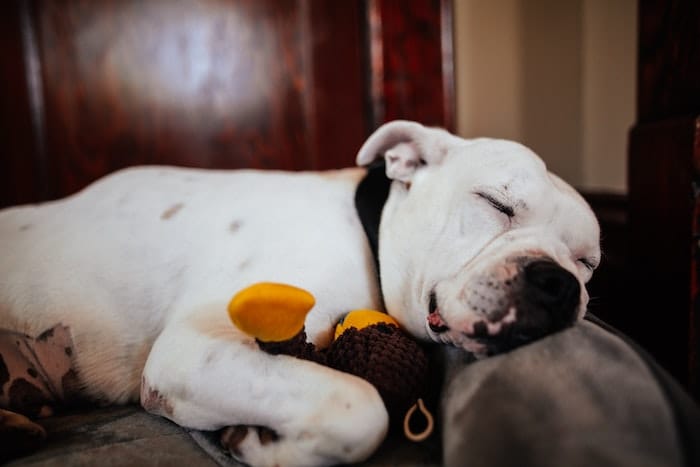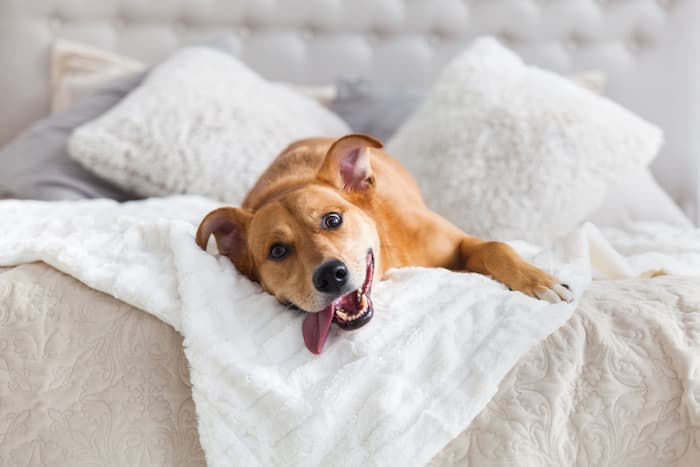Having a guide to make your dog sleep can be a real help if you’re having trouble getting your dog to sleep at night. There are plenty of things you can do to help your dog sleep better, including establishing a regular bedtime routine.
You can also lull your dog into a restful sleep by letting him or her lick or chew on something soothing. Also train your dogs to sleep in different sleeping positions for dogs for having a quick and peaceful rest.
Licking And Chewing Soothes Dogs
Unlike humans, dogs have the ability to soothe themselves through licking and chewing. This self-soothing behavior can relieve stress, boredom, and anxiety. Besides helping a dog relax, licking and chewing can also provide dogs with positive associations with their owners.
Although licking and chewing can be a harmless behavior, it can be a sign of a more serious underlying health issue. Excessive licking can indicate an allergic reaction, or may indicate a bacterial or yeast infection.
Excessive licking can also be caused by stress, anxiety, or boredom. A dog’s licking behavior may be self-perpetuating, which can be frustrating for owners. If your dog is licking and chewing excessively, you need to take action.
Dogs often lick their paws as a way to relieve itching. This type of itching is caused by parasites, bacteria, or other skin irritants. If you have a dog that is constantly licking its paws, you may need to consult a veterinarian.
Establishing A Bedtime Routine
Creating a bedtime routine for your dog is a great way to ensure that your pet has a great night’s sleep. It will also help your pet feel less anxious throughout the night. Creating a nighttime routine for your pet is not as simple as it sounds. It requires a little planning, some patience and a little bit of effort.
The best way to accomplish this is to follow a routine that you’re comfortable with. For example, you could set up a routine to take your dog out for a walk or go for a potty break in the middle of the night.
You can also give your dog a treat at bedtime to reinforce that this is his bedtime. You may want to consider putting your dog in a crate, but be aware that this can be a bit tricky. You’ll want to give your dog some time to adjust before putting him in the crate, so you can’t rush the process.
Melatonin
Taking a melatonin supplement for your dog can help them sleep better and stay calm. It can also help them deal with anxiety, separation anxiety, and phobias. However, it should be used with caution.
If you are considering giving your dog melatonin, you will want to speak to your veterinarian before doing so. They can determine the proper dose for your dog and help you select the right brand. You will also want to discuss any other medications your dog is taking. Many drugs interact with melatonin, so it is important to be aware of this.
If you are giving your dog melatonin for sleep, you will want to make sure it is a high-quality product. It should have clear directions and be free of fillers and additives or your dog can suffer from a melatonin overdose. There are also other reasons for a melatonin overdosage.
Insomnia In Dogs And Puppies
Unlike humans, dogs are not naturally prone to insomnia. However, it is something that they may suffer from from time to time. It is important to understand the signs and symptoms of canine insomnia and what you can do to help your pet sleep better.
One of the easiest ways to help your dog get a good night’s sleep is to ensure that he or she has a comfortable place to sleep. This may include a new sleeping area or a change in the type of bedding your dog uses.
Another good idea is to increase the amount of exercise your dog gets each day. This will give him or her the energy to fight insomnia at night. In addition to exercise, it is also important to ensure that your dog has a routine that will help him or her get a good night’s sleep. This could include a short nap in the middle of the day.
Conclusion
During the day, dogs sleep in naps. This is called slow wave sleep. During this phase, the breathing slows down and the heart rate slows down. Dogs also go through the REM stage. This stage is associated with the production of oxytocin, a hormone that helps to relieve pain and stress. While dogs are in this stage, they also tend to be relaxed and calm. This phase of sleep lasts between 10 and 15 minutes.
Related Reading



